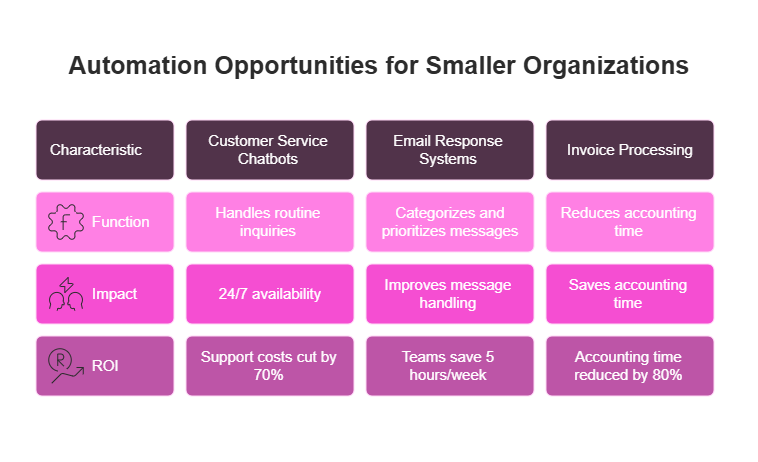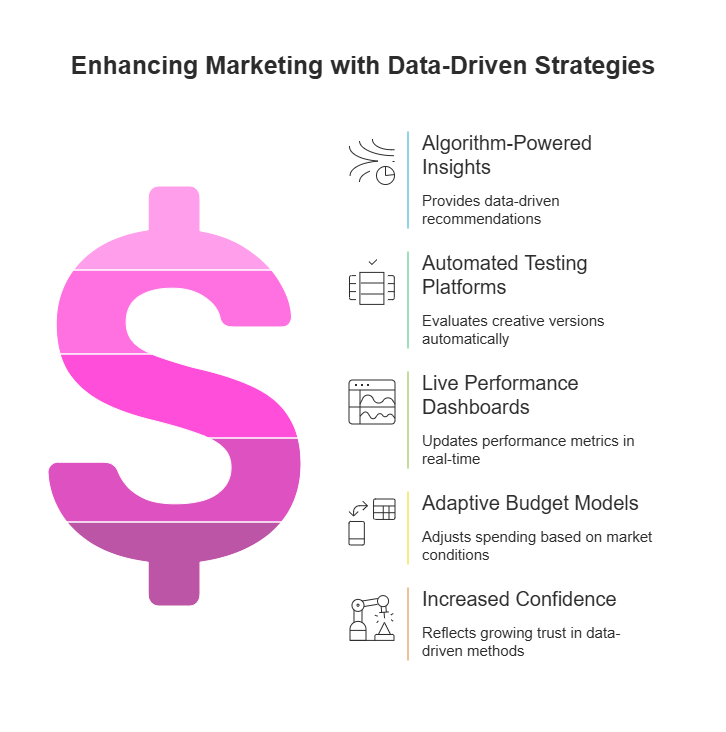This guide explores how AI automation workflows transform business operations through adaptive, intelligent systems. We cover everything from fundamentals to practical implementation strategies that deliver measurable results.
Whether you run a small business or manage enterprise operations, this guide provides actionable insights for harnessing AI automation to boost efficiency, reduce costs, and gain competitive advantages in today’s market.
Transforming Business Operations with AI Automation Workflows
Picture your team cutting manual tasks by half while gaining powerful insights that drive better decisions in real-time. This reality exists today through AI automation workflows, intelligent systems that go beyond executing repetitive tasks to actually learning and adapting based on data patterns. Unlike traditional automation that follows rigid rules, AI workflows analyze information, make decisions, and improve over time without constant human intervention.
For businesses of all sizes, these smart workflows deliver remarkable advantages. Small teams particularly benefit from automating customer service, data entry, and content management, freeing valuable hours for strategic work. According to a Gartner survey, 63% of organizations have already deployed AI solutions, showing how quickly this technology has moved from optional to essential.
The good news? Implementing AI automation no longer requires coding expertise or massive budgets. Platforms like Cubeo AI offer no-code solutions that let anyone create sophisticated workflows through simple drag-and-drop interfaces, making powerful automation accessible to teams without technical backgrounds.
What Are AI Automation Workflows?
AI automation workflows differ fundamentally from traditional rule-based systems. Regular automation follows fixed steps in sequence. In contrast, AI workflows adapt based on data patterns and outcomes. Harvard Business Review reports AI-powered workflows can reduce manual task time by up to 40%. They achieve this by processing information contextually instead of literally.
These intelligent systems blend data analysis with machine learning algorithms. By combining these elements, they make decisions without constant human oversight. Take customer service as an example. An AI workflow categorizes incoming requests automatically. It routes messages to appropriate teams. It can even draft responses based on past successful interactions. Meanwhile, the system keeps improving its accuracy through continuous learning.
The Evolution of Workflow Automation
Business process automation started with simple macros and rigid if-then rules. As a matter of fact, these early systems required exact conditions to function properly. The journey continued through robotic process automation (RPA), which mimicked human actions but still needed structured data.
AI marks a revolutionary step in this evolution. Modern workflows now understand context and recognize patterns. They make predictions based on experience, capabilities we could only dream about a decade ago.
Key Components of AI Powered Workflows
Effective AI workflows begin with robust data ingestion systems. These collect and standardize information from multiple sources. On the other hand, machine learning models serve as the “brain” of the operation. They analyze patterns and make predictions based on historical outcomes.
Integration layers connect these smart systems with existing business tools. This allows seamless data flow between applications. Research shows companies implementing these solutions see ROI ranging from 30% to 200% within the first year. Such financial impact demonstrates the value of well-designed AI components.
How AI Transforms Business Processes
Dynamic decision-making enables AI workflows to adapt to changing conditions. For instance, a manufacturing company using AI for quality control sees continuous improvement. The system refines its inspection parameters based on detected defects. It becomes more precise over time without manual adjustments.
Customer support experiences remarkable benefits from these technologies. Businesses report a 30% increase in customer satisfaction after implementing AI-driven service workflows. Response times drop significantly. The system handles routine inquiries automatically while escalating complex issues to human agents.
Fewer manual handoffs create smoother processes with reduced delays and errors. In a way, this transformation affects employee satisfaction too. Staff members enjoy their work more when AI handles repetitive tasks. This frees them to focus on creative and strategic work machines cannot replicate.
According to AI statistics, AI is projected to generate 170 million new jobs by 2030. We’ve observed that 80% of staff using AI report improved productivity. These numbers highlight why more businesses are adopting intelligent workflows across their operations.
Benefits of AI Workflow Automation for Businesses
AI workflow automation delivers measurable improvements that transform how businesses operate. What drives these changes? Data shows concrete results across multiple areas. A Deloitte report reveals 77% of early AI adopters cut costs by over 20%. Such numbers highlight why our interest in these technologies continues growing.
Beyond saving money, these systems create positive ripple effects throughout organizations. Teams focus on strategic work instead of repetitive tasks. Customers receive faster service with fewer errors. Leadership gains deeper insights for smarter decisions. Together, these advantages build competitive strength in fast-changing markets.
Increased Operational Efficiency and Productivity
How much time do routine tasks steal from your team? AI automation reclaims those hours by handling repetitive processes consistently. Your staff can then concentrate on innovation and customer relationships.
Organizations using AI workflows see a 35% productivity boost according to research. Real-world examples prove this point. One college saved 1,665 hours by automating workflows, freeing staff for more valuable activities. When routine work shifts to AI systems, human talent focuses where it matters most.
Cost Reduction Through Automated Processes
Financial benefits appear quickly after implementing AI workflows. Labor costs drop as teams accomplish more with fewer resources. Error-related expenses decrease thanks to AI’s consistency in execution.
Could your finance department save time? Research shows 80% of finance tasks could be automated, potentially freeing over 500 hours yearly per department. Manufacturing companies using AI-driven maintenance have reduced downtime by 15%. Each hour saved translates to direct production gains and cost savings.
Enhanced Decision-Making with AI-Driven Insights
Fast, data-informed decisions drive business success today. AI workflows excel at continuously analyzing information without manual effort. This capability transforms how we approach business intelligence.
• Real-time dashboards spot emerging trends
• Predictive models identify issues before they happen
• Automated reporting delivers insights immediately
These advantages explain why 68% of organizations report AI-driven insights speed up decision-making by one week on average. Faster decisions mean greater agility in responding to market shifts and customer needs.

Improved Customer and Employee Experiences
Customer expectations rise constantly. AI workflows help us meet these demands through consistent, personalized service. Companies using AI-powered customer interactions have boosted satisfaction scores by 22%.
What about employee satisfaction? Automation removes frustrating busywork from daily tasks. Staff members engage in more meaningful work when AI handles routine processes. This explains why 60% of companies now use automation solutions. The benefits extend beyond financial metrics to create better experiences for everyone involved with your business.
AI Workflow Automation for Small Businesses
Small businesses often face unique challenges: limited resources, tight budgets, and teams wearing multiple hats. Fortunately, AI workflow automation has become increasingly accessible, offering powerful solutions without enterprise-level investments. According to Forbes’ small business AI adoption guide, 59% of smaller companies plan AI pilots this year, with 48% reporting ROI within just three months of implementation.
The democratization of AI technology means smaller teams can now access tools previously available only to large corporations. These solutions help level the playing field, allowing companies to compete effectively while maintaining lean operations and focused spending.
Affordable AI Automation Solutions for Small Teams
Modern AI platforms offer tiered pricing models that grow with our business needs, making entry points remarkably affordable. Many solutions actually start with free trials or basic plans under $100 monthly, requiring minimal technical expertise to implement.
No-code interfaces eliminate the need for specialized developers, allowing team members to build workflows through intuitive drag-and-drop interfaces. This accessibility explains why 66% of companies have successfully automated at least one process, according to Software Oasis, with many reporting cost reductions between 10% and 50% through implementation.
Quick-Win Workflows with Immediate ROI
Several automation opportunities deliver rapid returns for smaller organizations:
- Customer service chatbots that handle routine inquiries 24/7
- Email response systems that categorize and prioritize messages
- Invoice processing that reduces accounting time by 80%
These quick wins explain why compact teams save an average of 5 hours per week using AI workflows, as reported by Forbes. One compelling example comes from a 10-person retailer that cut support costs by 70% after implementing AI chat.
Such results prove substantial improvements remain possible even with limited resources. In fact, the simplicity of modern platforms makes implementation surprisingly straightforward for organizations of any size.

Scaling Operations Without Scaling Headcount
Growth traditionally required proportional increases in staff, creating financial pressure during expansion phases. AI workflows sort of change this equation by handling increased workloads without additional personnel.
Automated onboarding processes ensure consistent customer experiences regardless of volume. Dynamic resource allocation adjusts to demand fluctuations automatically.
These capabilities help explain why 81% of decision-makers recognize automation benefits, according to Flowlu’s research. Similarly, Forbes notes that 42% of smaller firms reinvest automation savings into new technology.
The math becomes pretty compelling: when a marketing team automates routine posting and analytics, they can manage twice the campaigns without hiring additional staff. This efficiency creates a virtuous cycle where savings fund further automation, accelerating growth without corresponding cost increases.
Implementing AI Automation in Marketing Workflows
Marketing teams struggle with growing demands: more content, personalized experiences, and clear ROI, while resources stay limited. Smart automation turns these challenges into opportunities by handling repetitive work. In fact, nearly 70% of marketing professionals have already integrated intelligent tools into their operations, according to recent studies.
These solutions work so well in marketing because, well, the field has predictable patterns and tons of data to work with. Teams who adopt these approaches don’t just save time, they actually see better results across their campaigns.
Content Creation and Distribution Automation
Content bottlenecks vanish when smart assistants help with generation and distribution. Modern tools now draft emails, social posts, and ad copy in seconds instead of hours. According to research from Cubeo AI, these generative tools cut copywriting time in half, which basically frees up marketers to focus on strategy rather than production.
Distribution becomes just as smooth with automation. Smart systems analyze when audiences are most active, schedule content automatically, and adjust based on what works. One B2B company actually increased social engagement by 45% just by letting algorithms determine posting times. Almost all marketers (90%) report they’ve saved significant time on content scheduling.
The best systems create feedback loops where performance data automatically shapes future content decisions. This kind of self-improving system tends to get better results over time without constant manual adjustments.
Customer Journey Optimization with AI
Customer paths now wind through multiple channels and touchpoints, making them hard to track manually. Automated systems excel at following these journeys and personalizing experiences on the fly.
Smart segmentation tools continuously analyze behavior, creating audience groups that update in real-time. When paired with predictive analytics, these systems can sort of sense potential churn before it happens. This early warning triggers re-engagement workflows to bring at-risk customers back into the fold.
A major online retailer using this approach saw a 25% jump in conversion rates and 30% lower acquisition costs. The real advantage comes from messages that adapt based on individual responses rather than following rigid campaign rules.
Data-Driven Campaign Management
Marketing decisions improve dramatically with algorithm-powered insights. Testing platforms automatically evaluate different creative versions, shift budget to winners, and suggest practical next steps.
- Teams set up campaigns 60% faster through automation
- Performance dashboards update live without manual data entry
- Budget models adjust spending based on changing conditions
Confidence in these approaches continues growing, with about 20% of marketers now putting over 40% of their budgets into algorithm-driven campaigns. This shift makes sense given that 80% of marketing professionals believe smart automation has become essential for success in competitive markets.

How to Build Effective AI Automation Workflows
Creating successful AI automation requires a methodical plan rather than rushing into implementation. A structured approach helps avoid common pitfalls and maximize returns. Cubeo AI’s seven-phase development process offers a solid framework: purpose, data, team, tech, architecture, training, and deployment.
This systematic method explains why so many organizations see results. According to research, 64% of businesses expect efficiency boosts from automation solutions. Additionally, 25% of companies now rely on these systems for staffing relief.
Identifying Processes Ripe for Automation
We should start by mapping our organization’s workflows to find repetitive, high-volume tasks. These tasks typically consume significant resources and create bottlenecks. Document each process step, noting time requirements and error rates.
Quantify potential savings in concrete terms, like weekly hours saved and error reduction percentages. This analysis prioritizes opportunities with the highest ROI.
Companies like Amazon demonstrate this approach pretty well. They use automation to optimize supply chain operations, which reduces delays and prevents overstocking issues.
Focus first on processes where quick wins are possible. For instance, 29% of e-commerce teams using AI save about 6.4 hours weekly on tasks like order processing and inventory management.
Selecting the Right AI Automation Tools
Tool selection greatly affects implementation success. We should evaluate platforms based on several key factors.
First, consider ease of use versus customization needs. Next, check integration capabilities with existing systems. Scalability matters too as workflows grow over time. Vendor support and community resources can make a big difference. Finally, calculate the total cost of ownership.
The decision between no-code platforms and custom development depends on our team’s technical skills. No-code options speed up implementation but might limit complex customizations. Tesla’s approach shows this balance—they employ AI for predictive maintenance using specialized tools that work with their manufacturing systems.
Integration Strategies for Existing Systems
Smooth integration with current tools prevents workflow disruptions. Modern platforms offer pre-built connectors for popular business applications, which simplifies this process.
APIs basically serve as bridges between systems, allowing secure data flow. When planning integrations, we should document all data sources and destinations.
Clear data governance policies protect information integrity. Testing thoroughly before full deployment catches potential issues early. An incremental rollout minimizes disruption to daily operations.
Cubeo AI’s approach emphasizes deployment that includes integration and feedback loops. This ensures systems work together effectively while continuously improving performance.
Testing and Optimizing Your Workflows
Ongoing refinement maximizes performance of automation systems. We need to establish clear KPIs aligned with business goals, such as response times and accuracy rates.
Data should be split into training and testing sets to validate accuracy. This follows best practices in model development and evaluation.
A/B testing different workflow configurations helps identify optimal settings. Feedback mechanisms should capture performance data automatically for continuous improvement.
This refinement approach explains why 60% of businesses report significant productivity improvements after implementation. Netflix exemplifies this strategy by constantly refining their AI-powered recommendation system to improve viewer engagement.
Best Practices for AI Workflow Automation
AI workflow success relies heavily on execution strategies rather than technology choices. Organizations with the highest returns follow proven practices that maximize benefits while minimizing potential risks. In fact, a recent study shows that 92% of executives expect to implement AI-enabled automation by the end of 2025. We need to understand these practices now more than ever.
Four principles consistently appear in successful AI implementations. These include pilot projects with focused scope, appropriate human oversight, strong data quality and security, and clear metrics for measuring results. Each principle actually addresses specific challenges that teams face when adopting AI automation workflows.
Starting Small and Scaling Gradually
Large AI initiatives often collapse under excessive complexity. Smart organizations instead launch narrowly defined pilot projects that deliver quick wins while building team confidence.
Take Nextoria as a perfect example. This M&A advisory firm started with a focused AI workflow pilot and achieved a 35% reduction in deal closure time and 20% increase in deal value. Their success basically came from setting clear boundaries, collecting ongoing stakeholder feedback, and expanding only after validating initial results.
We’ve found that this step-by-step approach builds momentum through visible wins. It also allows teams to develop expertise before tackling more complex processes, which is really important for long-term success.
Balancing Automation with Human Oversight
Effective AI workflows enhance human capabilities rather than replacing them completely. According to recent research, about 72% of leaders view AI as augmenting human roles, not replacing them. Additionally, 68% report better results through human-AI collaboration.
Our recommended oversight mechanisms include:
- Strategic approval gates for important decisions
- Regular reviews of AI-generated outputs
- Clear frameworks for accountability in automated processes
- Training programs helping teams work effectively with AI systems
These practices ensure AI operates within appropriate ethical boundaries while leveraging human judgment for complex decisions that require empathy or ethical considerations.
Ensuring Data Quality and Security
AI workflows depend entirely on their underlying data quality. High-quality data produces reliable outputs, while poor data inevitably leads to unreliable AI decisions.
Security concerns grow alongside automation adoption. In our experience, robust data security practices should include:
- Comprehensive data validation processes
- Clear governance frameworks
- Encryption for all sensitive information
- Regular audits to detect bias in training data
- Secure data pipelines with appropriate access controls
Teams that prioritize these practices report fewer errors through consistent data validation. This approach essentially ensures AI workflows produce trustworthy results that users can confidently rely on.
Measuring Success and ROI
Concrete metrics transform AI from a tech experiment into a valuable business asset. McKinsey’s research indicates that companies tracking AI ROI see 3× higher adoption rates compared to those without measurement frameworks.
We recommend these measurement practices:
- Define key performance indicators before implementation
- Establish baseline metrics for accurate comparison
- Use real-time dashboards to monitor ongoing performance
- Schedule regular review sessions to evaluate results
Leading organizations focus on tangible metrics like cost savings, time reduction, and accuracy improvements. For example, one supply chain team reduced lead times by 20% through AI workflow optimization. This case study pretty much demonstrates how clear measurement frameworks drive continuous improvement in AI automation workflows.
Real-World Examples of Successful AI Automation Workflows
Let’s explore how real companies put AI automation into action with impressive results. These examples show what happens when theory meets practice in various business areas. Nearly 75% of businesses now use AI for at least one function, so we can learn a lot from their experiences.
Looking at these success stories helps us understand what’s possible with AI workflows. In fact, companies across different industries report similar patterns of improvement.
Customer Support Automation Case Study
Customer service teams often struggle with round-the-clock support demands. AI chatbots now handle routine questions automatically. More complex issues get routed to human agents when needed.
Salesforce reports a 50% reduction in support tickets after implementing AI support systems. These tools sort incoming requests and find answers from knowledge bases quickly.
A retail banking client saw resolution times drop from 26 hours to just 4 hours with AI support. This improvement boosted customer satisfaction scores significantly. Human staff could focus on complex cases requiring empathy and judgment.
HR and Recruitment Process Transformation
Hiring processes offer perfect opportunities for AI automation. Modern systems scan resumes and match qualifications to job requirements automatically. They rank candidates based on fit while reducing human bias.
Companies using these tools report 25% faster hiring times with better candidate quality. The AI helps standardize assessment criteria across all applications.
Wendy’s provides a great example of this approach in action. They use generative AI to streamline their hiring process across their restaurant network. This technology has basically transformed how they find and onboard new team members.
Sales and Lead Management Automation
Sales teams now use AI to spot promising leads and personalize outreach efforts. These systems analyze past data to predict which prospects might convert. This targeting helps teams focus their energy where it matters most.
Companies implementing these approaches see 20% higher lead conversion rates through smarter engagement. AI workflows enrich contact data and schedule follow-ups automatically.
One B2B software company tried an AI lead scoring system with amazing results. Their sales team reported 35% higher productivity by focusing on high-potential prospects. The AI analyzed past conversion patterns to identify the most promising leads.
Sales staff could sort of predict which deals would close, making their forecasts more accurate. This predictability helped with resource planning across the organization.
Operations and Supply Chain Optimization
Supply chains run smoother with AI automation that predicts demand changes. These systems optimize inventory and adjust production schedules in real time. Weather patterns, economic indicators, and historical data all factor into the calculations.
Retailers using these tools have reduced inventory errors by 30% while improving delivery times. General Motors shows how this works in practice, using AI to optimize manufacturing and supply chains.
The AI makes automatic adjustments to ordering quantities based on changing conditions. It also optimizes routing decisions and staffing levels as needed. These small tweaks add up to major efficiency gains over time.
Companies report fewer stockouts and less excess inventory sitting in warehouses. This balance means better cash flow and more satisfied customers too.
The Future of AI Workflow Automation
AI workflow automation evolves at a remarkable pace, with emerging technologies reshaping operational efficiency. Current systems represent just the beginning of what’s possible.
The next generation of AI workflows will feature greater autonomy, predictive capabilities, and seamless integration. These advancements will transform how we handle complex processes.
Forward-thinking organizations already prepare for these changes. In fact, 85% of enterprises plan to adopt AI agents by the end of 2025. Understanding these trends helps us stay ahead and position our businesses for future success.
Agentic AI and Autonomous Workflows
A significant evolution in AI workflows involves the shift from programmed automation to autonomous agents. These agentic systems don’t just follow rules. They actively pursue goals, make decisions, and learn from outcomes with minimal human guidance.
Retrieval-Augmented Generation (RAG) forms a foundation for this shift. RAG combines language model generation with live data retrieval through several steps. These include parsing, chunking, embedding, indexing, and storage. This approach prevents AI hallucinations by grounding responses in verified information.
The business impact is quite substantial. Companies using agentic AI have seen median productivity gains of 18%, with some exceeding 30%.
In a way, these systems transform entire operational models. A Deloitte case study showed 40% reduction in incident resolution times in complex service environments.
What makes these agents so revolutionary? They offer several key capabilities:
- They continuously improve through self-learning
- They coordinate across multiple systems independently
- They adapt to changing conditions using contextual awareness
- They basically develop novel solutions for unexpected problems
Predictive Workflow Optimization
AI now optimizes workflows before problems actually occur. These systems analyze patterns in historical and real-time data to anticipate needs.
Manufacturing facilities have, in some respects, led this adoption curve. Those implementing predictive maintenance have documented ROI exceeding 250% within 24 months.
The systems detect equipment anomalies weeks before traditional methods would. This early detection dramatically reduces downtime and maintenance costs.
Our market clearly recognizes this value. Projections show autonomous AI agent technologies reaching $156 billion by 2034.
This growth reflects a competitive advantage. Workflows now proactively optimize themselves rather than just executing fixed steps.
Cross-Platform Integration Advancements
Future AI workflows will span multiple platforms and departments seamlessly. Emerging standards for unified APIs enable data to flow across previously siloed systems.
This integration creates powerful capabilities that we can leverage across our organizations. Too often, we’ve seen disconnected systems limit potential.
The practical impacts of these advancements include:
- Complete visibility across entire value chains
- Unified dashboards monitoring all systems
- Consistent data governance regardless of origin
- Automated handoffs between specialized AI systems
Marketing campaigns adjust based on manufacturing capacity. Supply chains reconfigure in response to sales forecasts. Customer support accesses product development data instantly.
These connected systems create unprecedented efficiency while providing insights that were previously impossible to obtain. As we move forward, this integration will become a competitive necessity rather than just an advantage.
Getting Started with Cubeo AI for Workflow Automation
Turning AI concepts into reality becomes surprisingly simple with the right platform. The Cubeo AI no-code platform actually removes technical barriers, letting anyone create sophisticated AI workflows without programming knowledge. This accessibility aligns with current trends, as 60% of business executives believe democratizing AI development through no-code tools is crucial for their digital strategy.
We’ve designed Cubeo AI to simplify your journey from concept to implementation. The platform offers intuitive interfaces and pre-built templates. It also provides seamless integration capabilities for existing systems.
Building Your First AI Agent with No Code
Creating an AI agent with Cubeo AI takes minutes instead of months. The visual interface eliminates coding requirements completely.
Team members from any department can build functional AI agents through simple drag-and-drop actions. This approach is pretty revolutionary for non-technical users.
Start by selecting from dozens of pre-built skill templates. These are designed for specific business functions like customer support or content creation.
You can customize these templates by connecting your data sources. Just define parameters that match your specific requirements.
The platform handles technical complexity behind the scenes, managing infrastructure and security automatically. This explains why no-code platforms will power 70% of new enterprise applications by the end of 2025, accelerating digital transformation initiatives.
Creating an AI Dream Team for Your Business
Individual agents excel at specific tasks. Their true power emerges when assembled into coordinated AI Dream Teams.
Cubeo AI’s team-building framework follows five essential steps: objectives, agents, training, API linking, and lead agent designation.
This structure enables us to:
- Establish specialized roles for each agent based on unique business needs
- Develop seamless handoffs between agents for complete end-to-end processes
- Create feedback loops that continuously improve performance over time
- Maintain centralized oversight through strategically designated lead agents
Real-world applications include coordinated research and marketing teams. These AI Dream Teams work together to identify trends, create content, and distribute materials, all with minimal human intervention.
Automating Complex Workflows with Cubeo AI Triggers
Triggers transform static agents into dynamic workflow systems. They respond automatically to events and conditions in real-time.
Cubeo AI’s trigger system monitors for specific events, like new data arrivals or time-based conditions. It then initiates appropriate actions when these conditions are met.
You can configure triggers through the same no-code interface. Just define both the activation conditions and resulting actions.
Complex decision trees become possible through conditional logic. The system evaluates multiple factors before determining next steps.
The market for these capabilities continues expanding rapidly. AI agents are projected to reach $150 billion by the end of 2025.
Organizations implementing these systems report dramatic improvements. Customer service response times have been reduced by up to 90% in some cases. This happens through automated workflows that handle routine inquiries instantly while routing complex issues to specialists.
FAQs
How can small businesses start with AI workflow automation on a budget?
Small businesses can begin with affordable AI workflow automation tools. Many options range from $5-$50 per user monthly. Free trials allow testing features before committing. Focusing on budget-friendly features helps optimize costs.
What metrics should I track to measure AI workflow ROI?
To measure AI workflow ROI, track cost savings and revenue growth. Efficiency improvements, including time savings and output increases, are important. Also, monitoring customer engagement and satisfaction provides a comprehensive assessment. These metrics validate financial returns and improve operations.
What emerging trends will shape the future of AI workflow automation?
Intelligent orchestration is a key trend in AI workflow automation. Cloud-based solutions and enhanced efficiency through AI integration are also emerging. Real-time adaptability and reduced manual oversight will shape future automation. Businesses are using AI to optimize and scale complex automation processes across departments.



